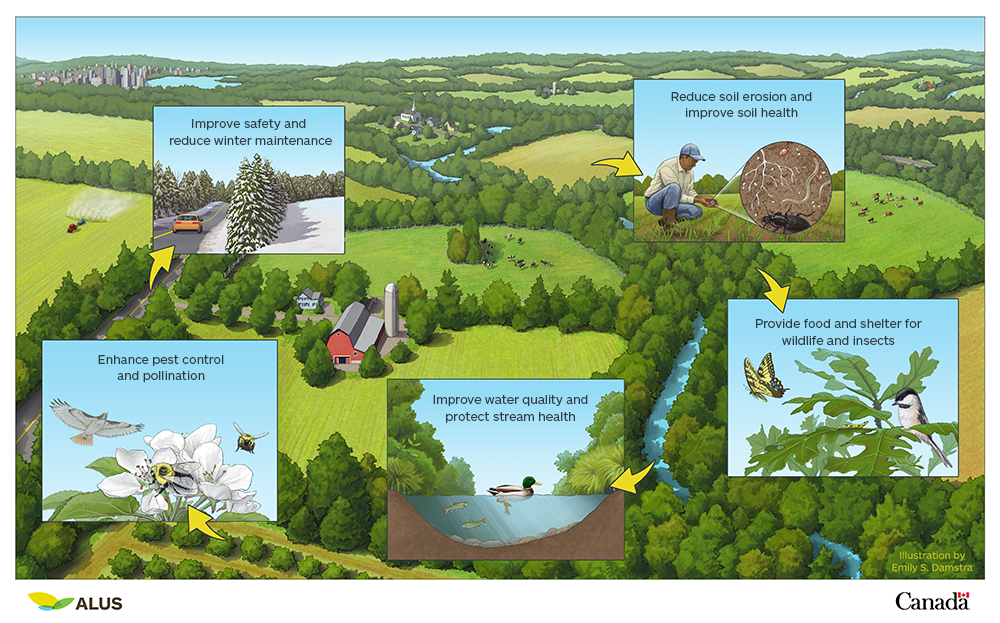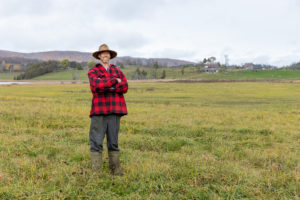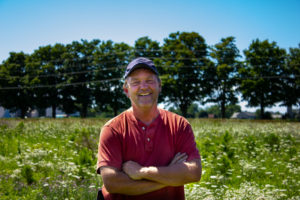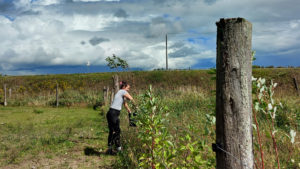The Benefits of Trees on the Farm
Planting Trees and Shrubs
Trees are a natural, multi-purpose tool that provide several benefits to the farm and surrounding community. You don’t need to plant a forest to make an impact. Smaller, strategic planting projects can address environmental challenges on the farm, enhance natural infrastructure and generate ecosystem goods and services that support resilient communities and help reduce the effects of climate change.
The benefits of trees on the farm
Reduce soil erosion
Trees keep soils in place, protect against harsh winds, cycle important nutrients and support healthy microbial activity and plant growth.
Protect herd health
Trees shelter barns and livestock from cold, winter winds and provide shade on hot summer days.
Clean the air
Trees capture and store carbon and protect against pesticide drift.
Improve water quality
Filters water to keep lakes, rivers and drinking water clean.
Increase biodiversity
Trees provide food and shelter year-round for wildlife and insects.
Enhance pest control and pollination
Trees attract birds, pollinators and beneficial insects that help control pests and support pollination.
Reduce winter maintenance
Trees reduce blowing and drifting snow on roads and driveways.
Protect stream health
Trees keep nutrients out of waterways, cool streams for coldwater fish and stop streambanks from eroding.
Reduce flood risk
Trees absorb water, slow run-off and disperse rainfall.

Tree planting projects for the working landscape
Windbreaks
A windbreak (or shelterbelt) is a linear planting of hardy trees and shrubs that can withstand harsh conditions and slow prevailing winds to help reduce soil erosion, protect crops and livestock, and reduce blowing and drifting snow.
Riparian Buffers
Riparian buffers are vegetated strips consisting of trees, shrubs and other plants that run adjacent to a stream, lake or wetland. They help reduce streambank erosion, keep nutrient and sediment out of waterways, enhance water quality and keep water cool for coldwater species.
Buffer Strips
A buffer strip is a linear stretch of natural vegetation, including trees and shrubs, that helps protect against pesticide drift, improves soil and water quality and provides habitat for pollinators and other wildlife.
Reforestation or Afforestation
Reforestation restores a previously forested area and afforestation creates new forests. Large tree planting projects help capture and sequester carbon, improve soil health, regulate air temperature and provide food and shelter for wildlife.
Put trees to work on your farm
Tree planting projects can benefit farms of all shapes, sizes and operations.
Connect with your community coordinator to learn about projects best suited to your farm.
Tree Planting Stories
Ian McClatchy: Putting Down Roots for the Environment
Jim Caley: Soil Erosion Be Gone
ALUS Tree Planting Supports National Biodiversity and Carbon Sequestration Targets



Just five minutes from the end of the highway, Rupert Hill Farm is nestled into the hills above the Gatineau River Valley. The land is beautiful and rolling, but in the lowlands, the wind can gather and howl across pasture. These landscape challenges are what has motivated Ian to undertake this windbreak project with ALUS, planting native trees and shrubs to slow the wind. But they do more than just that.
“Instinctually, we knew that there were some weak areas that were sandy and that we were probably losing our inputs on it,” said Jim of the struggle to keep sandy, erosion-prone land productive. “Then, with the last ten years or so of yield maps, we recognized that there were definitely some weak areas, unproductive.” After Jim assessed the yield maps, he made his decision: “Let’s do the tree thing.”
In 2021, ALUS communities planted 97,434 trees across 96 hectares of land in support of the Government of Canada’s 2 Billion Trees Commitment. ALUS tree planting projects enhance biodiversity and support carbon emissions reductions through land use changes, which result in the reduced use of synthetic inputs and emissions from heavy machinery, and through sequestration.
